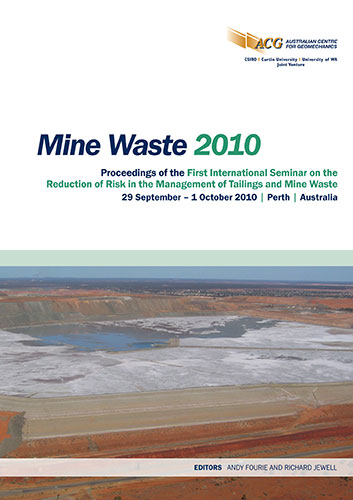Waste rock dump rehabilitation to a new level – Telfer WD13 constructed mesa landform

|
Authors: Mifsud, JA; Ryan-Reid, E; Wealleans, M |
DOI https://doi.org/10.36487/ACG_rep/1008_10_Mifsud
Cite As:
Mifsud, JA, Ryan-Reid, E & Wealleans, M 2010, 'Waste rock dump rehabilitation to a new level – Telfer WD13 constructed mesa landform', in R Jewell & AB Fourie (eds), Mine Waste 2010: Proceedings of the First International Seminar on the Reduction of Risk in the Management of Tailings and Mine Waste, Australian Centre for Geomechanics, Perth, pp. 103-117, https://doi.org/10.36487/ACG_rep/1008_10_Mifsud
Abstract:
Environmental expectations from the public have increased over the years. This has resulted in more demanding licence conditions for new mining operations. In addressing a ministerial condition to rehabilitate waste dumps to a condition that fits with the surrounding landforms, Newcrest’s Telfer Operations embarked on a research and development programme to landscape waste dumps into mesas, a dominant landform in the region. A series of trials were initiated on waste rock dumps to demonstrate that engineered mesas are potentially stable landforms and with the application of topsoil as a seed bank and growth medium can support vegetation. The experience from these trials was used in full-scale rehabilitation of waste dump WD13 at an abandoned mine pit. From November to December 2008, WD13 was reshaped into a mesa landform and covered with a topsoil waste rock mix. The 30 m face of the waste rock dump was pushed into an upper slope at 16° and the lower slope at 7° and competent waste rock was added to the crest as a perimeter bund and to give the appearance of a duricrust. The final landscape closely resembled mesa landforms in the region. Monitoring in October 2009, found the landform to be stable after exposure to several rain events, soil quality was unchanged and vegetation was establishing; Kapok Bush (Aerva javanica) an invasive weed, was the dominant emergent vegetation but many native species were also establishing. Spinifex was the dominant group of the native species.
References:
Beard, J.S. (1980) A new phytogeographic map of Western Australia, Western Australian Herbarium Research Notes 3:
45.
Hart, R. (1997) Section 1.7 in Notice of Intent Satellite Pit Operation - Fallow’s Field Prospect Telfer District, WA.
Addendum No. 1, By Newcrest Mining Limited, Telfer Gold Mine, October 1997.
Institution of Engineers Australia (1987) Australian Rainfall and Runoff – A Guide to Flood Estimation, Revised
Edition.
Waste rock dump rehabilitation to a new level – Telfer WD13 constructed mesa landform J.A. Mifsud et al.
118 Mine Waste 2010, Perth, Australia
© Copyright 2025, Australian Centre for Geomechanics (ACG), The University of Western Australia. All rights reserved.
View copyright/legal information
Please direct any queries or error reports to repository-acg@uwa.edu.au
View copyright/legal information
Please direct any queries or error reports to repository-acg@uwa.edu.au